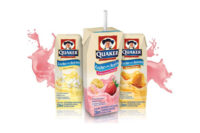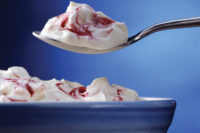Even though a cow’s diet includes a lot of high-fiber feedstuffs, fluid milk contains no fiber. Yet fiber is an excellent ingredient to boost the nutrition of a wide range of dairy products and dairy alternatives. Let’s explore the benefits of adding fiber to foods in the frozen and refrigerated dairy cases.
Fiber and prebiotic claims
Adding fiber allows for nutrient content claims of either good or excellent source of fiber, as well as numerous other claims. And prebiotic fibers bring additional benefits.
“Our short chain fructooligosaccharied (scFOS) is a soluble prebiotic fiber produced from non-GMO sucrose (cane sugar),” says Ivan Gonzales, marketing director, dairy for Ingredion Incorporated. “It can be incorporated into dairy formulations to promote digestive and immune system health benefits. The fiber also works as a complementary ingredient to support sugar reduction formulations.”
A review (https://tinyurl.com/y5omkg8h) by the International Association of Probiotics and Prebiotics (ISAPP) outlines the health benefits of prebiotics including FOS and galactooligosaccharides. The list includes benefits to the gastrointestinal tract (including inhibition of pathogens and immune stimulation), cardiometabolism (effects on blood lipid levels and insulin resistance), mental health (effects on metabolites that influence brain function) and bone mineral bioavailability.
Improving texture and nutrition
According to Ingredion research, texture is a strong driver of yogurt preference. The basic action of yogurt cultures on milk is to transform liquid milk into an acid-induced protein gel. Nondairy yogurt alternatives made with almond, oat, coconut or soy ingredients often use various fiber ingredients to create a texture and mouthfeel similar to dairy yogurt.
“Fiber ingredients can be used for both sugar and fat reduction,” says Kyle Krause, product manager, Beneo North America. “To achieve a creamy mouthfeel in yogurt or nondairy yogurt alternatives, use 2% to 5% chicory root fiber. In ice cream and frozen desserts, chicory root fiber can be used as at a level of 3% to 7%.”
While fiber is high on the list of nutrients consumers are seeking, sugar tops the list of ingredients of which consumers want less. Fiber helps dairy processors achieve this goal.
“To achieve sugar reduction in ice cream and frozen dairy desserts, we recommend using chicory root fiber in combination with erythritol and stevia, or other high-intensity sweeteners. In these situations, it is possible to achieve anywhere from 10-60% sugar reduction, without affecting sensory characteristics like taste and texture,” says Christine Addington, technical service representative, Cargill.
Now that’s a sweet substitution!








